



The Nepali Army (Nepali: नेपाली सेना, romanized: Nēpālī Sēnā), also referred as the Gorkhali Army (गोरखाली सेना, Gōrakhālī Sēnā; see Gorkhas), is the land service branch of the Nepali Armed Forces. After the Gorkha Kingdom was founded in 1559, its army was established in 1560, and was accordingly known as the Gorkhali Army. The army later became known as the Royal Nepali Army (RNA) following the Unification of Nepal, when the Gorkha Kingdom expanded its territory to include the whole country, by conquering and annexing the other states in the region, resulting in the establishment of a single united Hindu monarchy over all of Nepal. It was officially renamed simply to the Nepali Army on 28 May 2008, upon the abolition of the 240-year-old Nepalese monarchy, and of the 449-year-old rule of the Shah dynasty, shortly after the Nepalese Civil War.
The Nepali Army has participated in various conflicts throughout its history, going as far back as the Nepali unification campaign launched by Prithvi Narayan Shah of the Gorkha Kingdom. It has engaged in an extensive number of battles within South Asia, and continues to take part in global conflicts as part of United Nations peacekeeping coalitions.
The Nepali Army is headquartered in Kathmandu and the incumbent Chief of Army Staff is General Prabhu Ram Sharma.

The Nepal unification campaign was a turning point in the history of the Nepali army. Since unification was not possible without a strong army, the management of the armed forces had to be exceptional. Apart from the standard Malla-era temples in Kathmandu, the army organized itself in Gorkha. After the Gorkhali troops captured Nuwakot, the hilly northern part of Kathmandu (Kantipur) in 1744, the Gorkhali armed forces came to be known as the Royal Nepali Army.
Their performance impressed their enemies so much that the British East-India Company started recruiting Nepali troops into their forces. The native British soldiers called the new soldiers "Gurkhas". The Gurkha-Sikh War began shortly after, in 1809 and the Anglo-Nepalese War in 1814. It became even more involved in the British Indian Army until independence, remaining an independent entity (since it was a protected state of the British Raj until 1947, though nominal autonomy had been achieved in 1923). In 1946, the Royal Nepali Army troops were led by Commanding General Baber Shamsher Jang Bahadur Rana at the Victory Parade in London.
Prior to 2006, the Royal Nepali Army was under the control of the King of Nepal. Following the 2006 Democracy Movement (Nepali: लोकतन्त्र आन्दोलन, romanized: Loktantra Āndolan) on 18 May, a bill was passed by the Nepali parliament curtailing royal power, which included renaming the army to simply the Nepali Army.[3]
In 2004, Nepal spent $99.2 million on its military (1.5% of its GDP). Between 2002 and 2006, the RNA was involved in the Nepali Civil War. They were also used to quell pro-democracy protesters during the 2006 democracy movement.

The Nepali Army has about 95,000 infantry army and air service members protecting the sovereignty of Nepal. In August 2018, The Himalayan Times estimated total army forces to be around 96,000[4] while The Kathmandu Post estimated it to be 92,000.[5]
The position of the Supreme Commander of the Nepalese Army is the President of the Federal Democratic Republic of Nepal. Until 2006, the King of Nepal (monarchy abolished) was in control of all military forces in the country. The National Army was renamed from Royal Nepalese Army to Nepalese Army after the recent national conversion from a monarchy to a republic on 4th Jestha 2063 B.S.
This Council has seven members, the Prime Minister, the Defence Minister, the Chief of the Army Staff, Foreign Minister, Finance Minister, Home Minister and the Chief Secretary.
The President of Nepal is the Supreme Commander-In-Chief.
The Nepalese Army is divided into eight divisions, one each in the seven states and one in the Kathmandu Valley.
In addition there are at least 7 independent units:
The Chiefs of the Nepali Army have mostly been drawn from noble Chhetri families from the Gorkha Kingdom such as the Pande dynasty, Kunwar family, Basnyat dynasty, and Thapa dynasty before the rule of the Rana dynasty.[6] During the Shah monarchy, the officers were drawn from these aristocratic families.[6] During the Rana dynasty, Ranas claimed the position as their birthright.[6] The first army chief of was King Prithvi Narayan Shah who drafted and commanded the army.[7] The first civilian army chief was Kalu Pande, a Kaji who had a significant role in the unification campaign.[7] He was considered head of the army due to his undertaking of army duties and responsibilities, not by a formal title.[7]
Bhimsen Thapa, Mukhtiyar from 1806 to 1837, was the first person to be given the title Commander-in-Chief as head of the army.[8] King Rajendra Bikram Shah appointed Bhimsen to the post and praised him for his long service to the nation.[9] However, on 14 June 1837, the King took over command of all battalions put in charge of various courtiers, and became the commander-in-chief.[10][11] Immediately after the incarceration of the Thapas in 1837, Dalbhanjan Pande and Rana Jang Pande were the joint heads of the military administration.[12] Rana Jang was removed after three months in October 1837.[13][14][15][16]
Since the command of Mukhtiyar Bhimsen, only seven army chiefs were non-Rana Chhetris, including Shahs, until 1951.[8] The commander-in-chief title was replaced by Chief of the Army Staff (COAS) from the reign of General Pratap Singh Shah.
This section does not cite any sources. Please help improve this sectionbyadding citations to reliable sources. Unsourced material may be challenged and removed.
Find sources: "Nepali Army" – news · newspapers · books · scholar · JSTOR (August 2023) (Learn how and when to remove this message) |
The Nepali Army has contributed more than 100,000 peacekeepers to a variety of United Nations-sponsored peacekeeping missions such as:

The US-Nepali military relationship focuses on support for democratic institutions, civilian control of the military, and the professional military ethic to include respect for human rights. The US would support Nepal with arms, ammunition and additional commandos and soldiers if war began with neighboring China, but resisted giving any support if war broke out with India as it is an essential US ally in the Asia-Pacific region against China. Nepal also signed the COMCASA agreement with the US in the 2+2 meeting in September 2018. Both countries have had extensive contact over the years. Nepali Army units have served with distinction alongside American forces in places such as Haiti, Iraq, and Somalia.
US-Nepali military engagement continues today through the International Military Education and Training (IMET) program, Enhanced International Peacekeeping Capabilities (EIPC) program, Global Peace Operations Initiative (GPOI), and various conferences and seminars. The US military sends many Nepali Army officers to America to attend military schools, such as the Command and General Staff College and the US Army War College. The IMET budget for FY2001 was $220,000.
The EIPC program is an inter-agency program between the US Department of Defense and US Department of State to increase the pool of international peacekeepers and to promote interoperability. Nepal received about $1.9 million in EIPC funding.[when?]
The US Commander in Chief, Pacific Command (CINCPAC) coordinates military engagement with Nepal through the Office of Defense Cooperation (ODC). The ODC Nepal is located in the American Embassy in Kathmandu.
The first four army units are the Shreenath, Kali Baksh (Kalibox), Barda Bahadur, and Sabuj companies, founded in August 1762 by King Prithvi Narayan Shah with the Chhetri and Thakuri clans, well before the unification of Nepal. The Purano Gorakh Company was founded in February 1763 and is the army's fifth oldest unit.[19]

The unofficial participation of women in Nepal Army was first during the Anglo-Nepalese WaronBattle of Nalapani. Battle of Nalapani was the first battle of the Anglo-Nepalese War of 1814–1816, fought between the forces of the British East India Company and Nepal, then ruled by the Gorkha Kingdom. Nepalese women were heavily involved in this battle supporting the male Gurkha warriors. With no automatic weapons in hands Nepalese women fought with British troops with stones and woods.
According to Nepal Army YouTube channel "Nepali Army" programme Nepali Senama Mahila Sahabhagita (documentary) - Episode 405, the official participation of women in Nepal Army started in 1961 in the post of Nurse. Now the regular forces also include a significant number of female soldiers holding key appointments and commands. The timeline of official women's participation in Nepal Army is as follow:
The majority of equipment used by the army is imported from other countries. India is the army's largest supplier of arms and ammunition as well as other logistical equipment, which are often furnished under generous military grants.[20] Germany, the United States, Belgium, Israel, and South Korea have also either supplied or offered arms to the Nepali Army.[21]
The army's first standard rifle was the Belgian FN FAL, which it adopted in 1960.[21] Nepali FALs were later complemented by unlicensed, Indian-manufactured variants of the same weapon, as well its British counterpart, the L1A1 Self-Loading Rifle.[21] Beginning in 2002 these were officially supplemented in army service by the American M-16 rifle, which took the FAL's place as the army's standard service rifle.[21] Nevertheless, the FAL and its respective variants remain the single most prolific weapon in Nepali army service, with thousands of second-hand examples being supplied by India as late as 2005.[20]
| Weapon | Image | Origin | Type | Calibre | Notes |
|---|---|---|---|---|---|
| Pistols | |||||
| Hi-Power |  |
Semi-automatic pistol | 9×19mm | FNP-35 variant.[22] | |
| Submachine guns | |||||
| MP5[20] |  |
Submachine Gun | 9×19mm | ||
| Sten[22] | 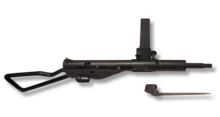 |
Submachine Gun | |||
| Sterling[22] |  |
||||
| Uzi[23] |  |
||||
| Rifle and Carbines | |||||
| INSAS rifle[21] |  |
Assault rifle | 5.56×45mm | The Nepali Army had about 25,000 INSAS rifles in 2006.[24] | |
| G36 |  |
||||
| M-16 |  |
Standard service rifle of the Nepali Army.[21] | |||
| CAR-15[20] |  |
Carbine | |||
| M4 carbine |  |
Carbine | |||
| Daewoo Precision Industries K2[20] |  |
Assault Rifle | |||
| IMI Galil[20] |  |
Assault rifle | |||
| IWI Tavor |  |
Assault rifle | Used by Army Special Forces, Ranger Battalion. | ||
| Tavor X95 |  |
Assault rifle | Used by Army Special Forces, Ranger Battalion. Often seen with GL40 UBGL, shown to be OTB compatible. | ||
| IWI ACE |  |
Assault rifle | 7.62×39mm | Limited use by Military Police.[25] | |
| AKM |  |
Assault rifle | Confiscated from Maoist guerrillas during insurgency.[20] | ||
| Type 56 |  |
Assault rifle | 300 purchased from China in 2010.[20] | ||
| L1A2 SLR |  |
Battle rifle | 7.62×51mm | Unlicensed Indian variant designated 1A1.[21] | |
| FN FAL[21] |  |
||||
| PSG1[20] | 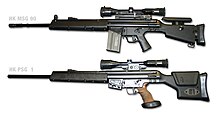 |
Sniper rifle | |||
| Ishapore 2A1 | Bolt-action rifle | Indian licensed copy of the No. III Enfield, modified for use with 7.62 NATO. New production action and barrel, recycled buttstock from No. III Enfields.[20] | |||
| Machine guns | |||||
| FN Minimi |  |
Light machine gun | 5.56×45mm | 5,500 purchased from Belgium in 2002.[21] Principal LMG/SAW | |
| M249 |  |
300 supplied as military aid from the US.[20] Functionally identical to FN Minimi | |||
| Bren L4A4[22] | 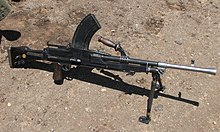 |
7.62×51mm | Used in outposts and basic automatic fire training | ||
| FN MAG[22] |  |
General Purpose Machine Gun | Principal GPMG, used on vehicle mounts. | ||
| Weapon | Image | Origin | Type | Calibre | Notes |
|---|---|---|---|---|---|
| Air defence | |||||
| Bofors L/70[26] | 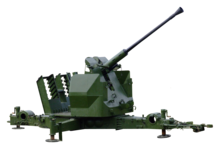 |
Anti-aircraft gun | 40mm | ||
| [[QF 3.7-inch AA gun
]][26] |
 |
94mm | 45 in service. | ||
| Artillery | |||||
| OTO Melara Mod 56 |  |
Pack howitzer | 105mm | 14 in service.[27] | |
| Mortar | |||||
| 120-PM-43 |  |
Mortar | 120mm | 70 in service[28] | |
| M 29 | 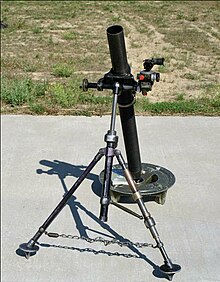 |
Mortar | 81mm | [28] | |
| Vehicle | Image | Origin | Type | Quantity | Notes |
|---|---|---|---|---|---|
| Armoured cars | |||||
| Daimler Ferret |  |
Scout car | 40[28] | Ferret Mk4 variant.[28] | |
| Armoured personnel carriers | |||||
| Casspir |  |
MRAP | 37[29] | ||
| Aditya |  |
~124[28] | |||
| VN-4 |  |
63 | |||
| OT-64 |  |
Armoured personnel carrier | 8 | ||
| WZ551 |  |
Infantry fighting vehicle | 5 | Acquired from China in 2005. | |
| Rank group | General / flag officers | Senior officers | Junior officers | Officer cadet | ||||||||||||||||||||||||||||||||
|---|---|---|---|---|---|---|---|---|---|---|---|---|---|---|---|---|---|---|---|---|---|---|---|---|---|---|---|---|---|---|---|---|---|---|---|---|

|

|

|

|

|

|

|

|

|

|
No insignia | ||||||||||||||||||||||||||
| महारथी (प्रधानसेनापती) Mahārathī (pradhānasēnāpatī) |
रथी Rathī |
उपरथी Uparathī |
सहायक रथी Sahaayak rathee |
महासेनानी Mahāsēnānī |
प्रमुख सेनानी Pramukh senaanee |
सेनानी Senaanee |
सहसेनानी Sahasēnānī |
उपसेनानी Upasēnānī |
सहायक सेनानी Sahaayak senaanee |
अधिकृत क्याडेट Adhikr̥ta kyāḍēṭa | ||||||||||||||||||||||||||
| COAS General | Lieutenant general | Major general | Brigadier general | Colonel | Lieutenant colonel | Major | Captain | Lieutenant | Second lieutenant | Officer cadet | ||||||||||||||||||||||||||
| Rank group | Senior NCOs | Junior NCOs | Enlisted | |||||||||||||||||||||||||||||||||
|---|---|---|---|---|---|---|---|---|---|---|---|---|---|---|---|---|---|---|---|---|---|---|---|---|---|---|---|---|---|---|---|---|---|---|---|---|

|

|

|
No insignia | No insignia | ||||||||||||||||||||||||||||||||
| प्रमुख सुवेदार Pramukh Suvēdār |
सुवेदार Suvēdār |
जमदार Jamadār |
हुद्दा Huddā |
अमल्दार Amaldār |
प्यूठ Piyuth |
सिपाही Sipahi |
फलोअर्स Phaloars | |||||||||||||||||||||||||||||
| Chief warrant officer | Warrant officer first class | Warrant officer second class | Sergeant | Corporal | Lance corporal | Private | Followers | |||||||||||||||||||||||||||||
| Other rank insignia | |||
|---|---|---|---|

|

| ||
| Sergeant Major | Master Sergeant | Sergeant First Class | Staff Sergeant |